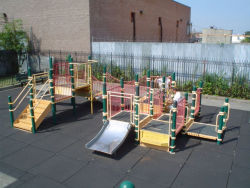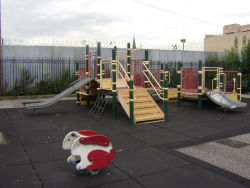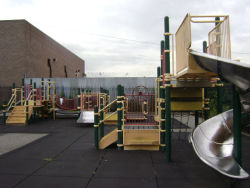Weeksville Playground
Weeksville Playground
Weeksville Playground is named for the historically significant community of Weeksville. Founded in 1838, eleven years after slavery ended in New York State, Weeksville was a long-lasting and thriving community of self-sufficient free African-American landowners in what is today Crown Heights and Bedford Stuyvesant. The community took its name after James Weeks, who purchased his first plot of land in 1838 and became one of the communities’ largest property owners. Over time Weeksville became both a safe haven and a refuge from violence and oppression and a place for African people throughout the diaspora to seek political, economic, and cultural independence. By 1850, it had become the second largest community for free men and women in pre-Civil War America.
Weeksville was known for self-sufficiency and included doctors, professionals, and entrepreneurs. It was one of the few communities in which free people of color could independently practice their profession in New York City. Residents established schools, sports clubs, benevolent associations, an elderly home and an orphanage among other enterprises.
The community of Weeksville allowed for political and intellectual freedom and was an important site for abolitionist action. During the Manhattan Draft Riots of 1863, when mobs of white men and women attacked and killed African women and men in downtown Manhattan, Weeksville became a refuge for those fleeing the violence. Community members participated in anti-slavery actions and, after abolition, promoted equal rights for free men and women through voting rights campaigns and influential publications. By the post-Civil War era, Weeksville had become an emblem of community empowerment and racial pride.
Due to 20th century demographic changes and large-scale construction projects, the strong community identity that had formed in Weeksville over the previous 100 years gradually faded. By the 1950s, the community of Weeksville was almost completely forgotten. In 1968, the rediscovery of Weeksville began when historian James Hurley and pilot Joseph Haynes, along with a dedicated group of researchers, teachers, students, leaders, youth, and volunteers of the community, worked together to document the history of Weeksville and the homes now known as the Historic Hunterfly Road Houses.
The Historic Hunterfly Road Houses are some of the only existing remnants of 19th-century Weeksville. As a result of strong community advocacy and the leadership and dedication of Dr. Joan Maynard, the houses were preserved and landmarked in 1970. Today the Historic Hunterfly Road Houses have been fully restored and are open to the public at the Weeksville Heritage Center. Located at the intersection of Bergen Street and Buffalo Avenue (Dr. Joan Maynard Way), Weeksville Heritage Center continues to examine and highlight the historic significance of the Historic Hunterfly Road Houses and the history of the Weeksville community while extending Weeksville’s legacy of creativity, self-sufficiency, and entrepreneurship.
Check out your park's Vital Signs
Clean & Safe
Green & Resilient
Empowered & Engaged Users
Share your feedback or learn more about how this park is part of a
Vital Park System



